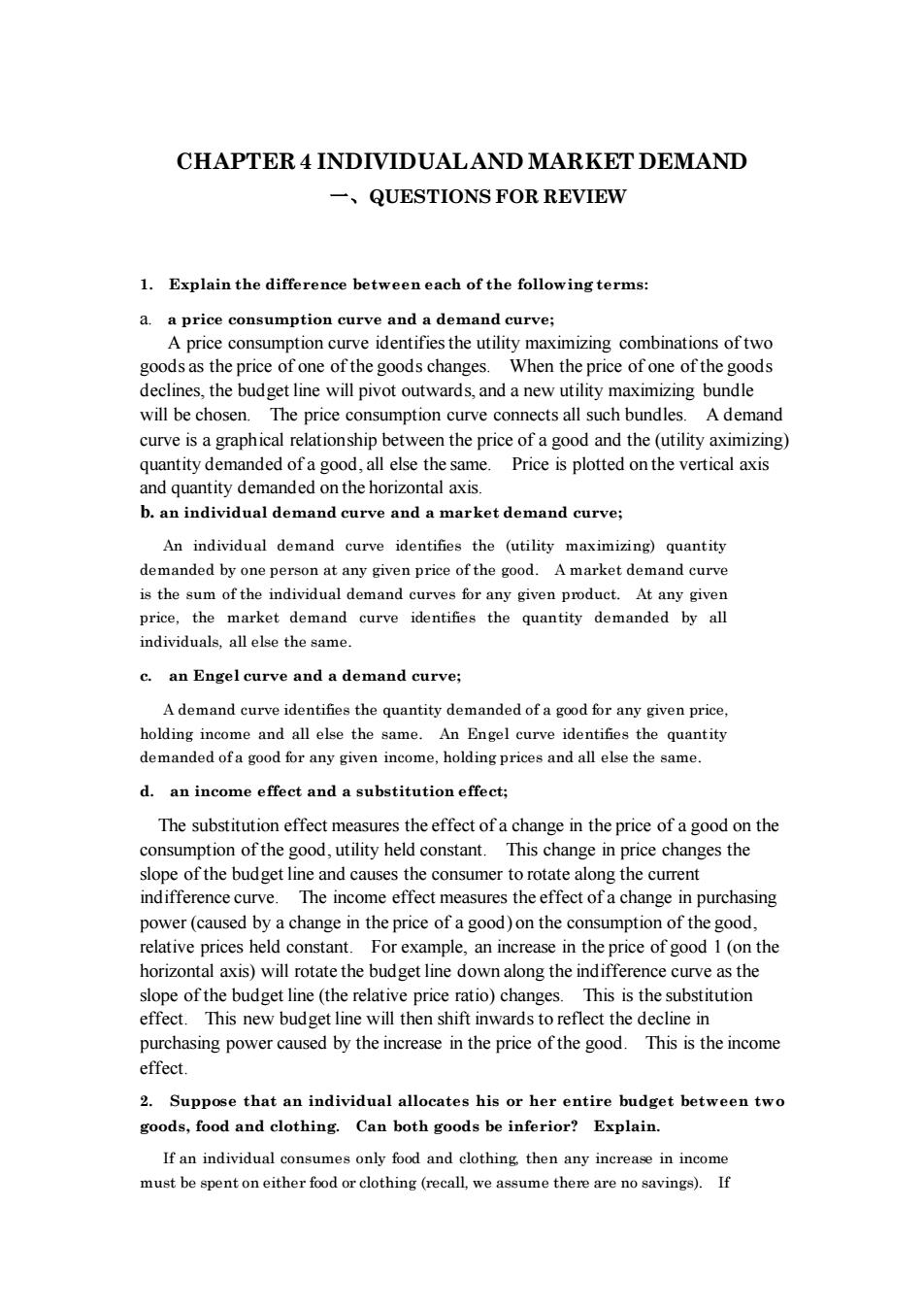正在加载图片...

CHAPTER 4 INDIVIDUALAND MARKET DEMAND 一、QUESTIONS FOR REVIEW 1.Explain the difference between each of the following termss a.a price consumption curve and a demand curve; A price consumption curve identifies the utility maximizing combinations of two goods as the price of one of the goods changes.When the price of one of the goods declines the budget line will pivot outwards and a new utility maximizing bundle will be chosen. The price sumption curve connects all such bundles. A demand curve is a graphical relationship between the price of a good and the(utility aximizing) quantity demanded of a good,all else the same.Price is plotted on the vertical axis and quantity demanded on the horizontal axis. b.an individual demand curve and a market demand curve; An individual demand curve identifies the (utility maximizing)quantity demanded by oneper at any given price of the good.Amarket demand the of the individual demand At any giver price,the e market demand curve identifies the quantity demanded by al individuals,all else the same. c.an Engel curve and a demand curve; A demand curve identifies the quantity demanded of a good for any given price. holding income and all else the same.An Engel curve identifies the quantity demanded ofa good for any given income,holding prices and all else the same. d.an income effect and a substitution effect: The the effect ofachange in the price on the consumption of the good,utility held constant This change in price changes the slope of the budget line and causes the consumer to rotate along the current indifference curve.The income effect measures the effect of a change in purchasing power(caused by a change in the price of a good)on the consumption of the good. relative prices held co nstant For ex ample,a inrease in the price of good 1(onthe horizonta axis)will rotate the budget line down along the indifferen e curve as the slope of the budget line(the relative price ratio)changes. This is the substitution effect.This new budget line will then shift inwards to reflect the decline in purchasing power caused by the increase in the price of the good.This is the income effect. 2.Suppose that an individual allocates his or her entire budget between two goods,food and clothing. Can both goods be inferior?Explain If an individual consumes only food and clothing then any increase in income must be spent oneither foo or elothing (recall,we assume there are no saving).IfCHAPTER 4 INDIVIDUAL AND MARKET DEMAND 一、QUESTIONS FOR REVIEW 1. Explain the difference between each of the following terms: a. a price consumption curve and a demand curve; A price consumption curve identifies the utility maximizing combinations of two goods as the price of one of the goods changes. When the price of one of the goods declines, the budget line will pivot outwards, and a new utility maximizing bundle will be chosen. The price consumption curve connects all such bundles. A demand curve is a graphical relationship between the price of a good and the (utility aximizing) quantity demanded of a good, all else the same. Price is plotted on the vertical axis and quantity demanded on the horizontal axis. b. an individual demand curve and a market demand curve; An individual demand curve identifies the (utility maximizing) quantity demanded by one person at any given price of the good. A market demand curve is the sum of the individual demand curves for any given product. At any given price, the market demand curve identifies the quantity demanded by all individuals, all else the same. c. an Engel curve and a demand curve; A demand curve identifies the quantity demanded of a good for any given price, holding income and all else the same. An Engel curve identifies the quantity demanded of a good for any given income, holding prices and all else the same. d. an income effect and a substitution effect; The substitution effect measures the effect of a change in the price of a good on the consumption of the good, utility held constant. This change in price changes the slope of the budget line and causes the consumer to rotate along the current indifference curve. The income effect measures the effect of a change in purchasing power (caused by a change in the price of a good) on the consumption of the good, relative prices held constant. For example, an increase in the price of good 1 (on the horizontal axis) will rotate the budget line down along the indifference curve as the slope of the budget line (the relative price ratio) changes. This is the substitution effect. This new budget line will then shift inwards to reflect the decline in purchasing power caused by the increase in the price of the good. This is the income effect. 2. Suppose that an individual allocates his or her entire budget between two goods, food and clothing. Can both goods be inferior? Explain. If an individual consumes only food and clothing, then any increase in income must be spent on either food or clothing (recall, we assume there are no savings). If